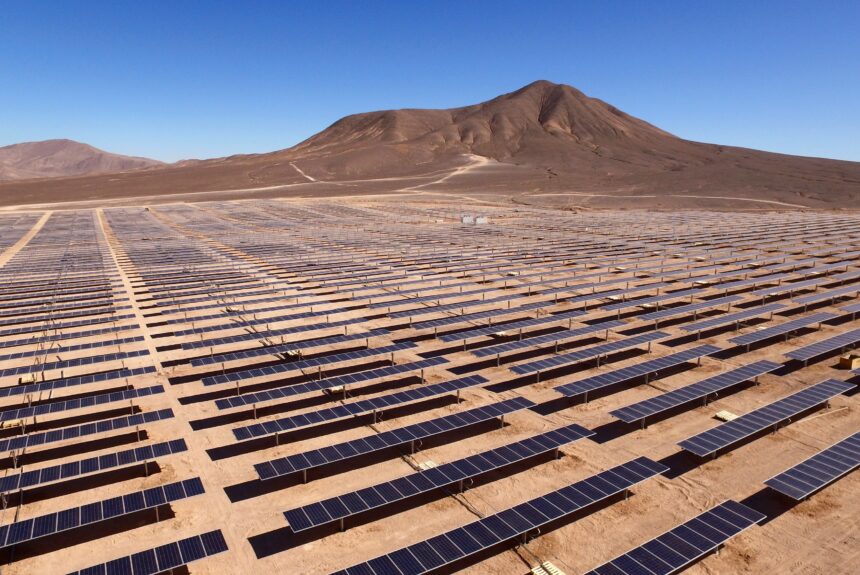Questions about the best place to put solar panels arise as more parts of the world get on board. Some efforts center on making existing large spaces — such as parking lots and farmland — share the real estate with solar panels. Relatedly, many solar industry professionals wonder if desert solar farms should be expanded due to the vast landscapes and amount of sunlight that deserts receive.
Desert Solar Projects Are Happening Now
Solar power in the desert is far from a new concept. In September 2011, the U.S. Department of Energy (DOE) provided two partial loan guarantees of $1.5 billion to finance the Desert Sunlight project in Riverside, California. It began operating in January 2015. Ivanpah is another solar plant in the California desert that received a loan guarantee from DOE, which has had some mixed economic and environmental results.
>>>READ: Space Solar is the Next Energy Market
Mexican officials want to build Latin America’s largest solar park in Mexico’s Northern desert. China also has its sights set on the desert to meet ambitious solar and wind energy goals. The first project can power 1.5 million homes, making it a substantial renewable energy contributor.
The Potential Challenges
It’s well-established that solar panels can help the world meet its energy needs and reduce global emissions. Solar panel prices have dropped significantly over the last several decades. Monocrystalline panels are the most efficient, reaching more than 20% efficiency in ideal conditions. Hot and dry desert surfaces receive more than twice the solar radiation of humid regions.
One of the challenges of running desert solar farms is keeping the panels cool. Temperatures that are too high reduce solar panel efficiency and require more regular maintenance for the panels. In 2021 a group of scientists from the Imam Abdulrahman Bin Faisal University in Saudi Arabia tested several cooling options and found that the most effective possibility relied on immersing four heat pipes in water. However, water is difficult to come by in the desert, and operating such a system might prove to be quite labor and resource-intensive.
Additionally, solar panels become less effective with dust coatings, and they need more frequent cleaning compared to installations in other environments. Given the remote locations of these solar deserts, regularly getting maintenance crews to service the panels may prove to be challenging. Some work in this area centers on using drones or other robots to do the job. However, many projects are still in the research phase.
The prospect of putting solar farms in the desert increases the likelihood of greater distances between where power generation occurs and energy demand exists. A Lawrence Berkeley National Lab study indicated transmission-related expenses could cause a 3%–33% rise in direct costs. Additionally, the data showed renewables have a levelized transmission capital cost averaging $1-10 per megawatt-hour.
In addition to technical challenges, developers also face issues related to NIMBYism. The Battle Born Solar Project in Nevada–which would have been the largest in the U.S.—was halted by Solar Partners VII, LLC, a company involved in the project. Local organizations pushed back on the project, claiming that it would prevent recreational activities and be an eyesore to the community.
Potential Unintended Consequences
While solar panels offer carbon-free power generation, research suggests that desert solar farms might have several unintended environmental consequences. A team investigating the effects of putting solar farms in the Sahara Desert recently found that covering 50% of the desert with solar panels would cause temperatures in the region to rise by 2.5° Celsius (4.5° Fahrenheit). That change would happen when the solar farms emit unused sunlight as heat. This effect would result in a 0.39° C (0.7° F) global increase, impacting polar regions the most.
>>>READ: Parking Lot Power Is The New Big Thing
Additionally, deserts aren’t always as empty as they seem, especially as they span increasingly large areas. For example, California’s Riverside East Solar Energy Zone stretches across 150,000 acres and had a population of 84,443 as of 2008.
People living near desert solar sites under construction complain of dust-related breathing problems. Some also believe water use associated with these projects caused the drying up of two wells. The parties overseeing renewable energy projects also have to ensure that they do not span across indigenous cultural sites, disrupt local ecosystems, or affect species and their habitats.
For instance, conservationists worry that a proposed Mojave Desert solar farm could thwart plans to have three wildlife overcrossings. Christina Aiello — an Oregon State University biologist and expert on the area’s bighorn sheep — said the worst-case scenario would see bighorn sheep start avoiding the area, making wildlife overcrossings useless.
Other informed individuals see additional possibilities, though. Dr. Eric Nordberg of the University of New England studies how wildlife responds to human-caused environmental changes. He suggests strategies such as planting vegetation between solar panels and connecting solar farms to other vegetated areas. These features encourage animals to live happily and safely near the renewable energy infrastructure.
Proceed With Caution
Desert-located solar farms provide an opportunity to expand clean power generation but face technological, economic, and environmental challenges. Thorough but efficient environmental assessments should weigh the costs and benefits and evaluate the effects on people, wildlife ecosystems, and cultural or historical sites. Putting a solar farm in the desert isn’t a guaranteed win and the parties involved must plan how to overcome the anticipated obstacles before proceeding.
Jane Marsh is the Editor-in-Chief of Environment.Co.
The views and opinions expressed are those of the author’s and do not necessarily reflect the official policy or position of C3.
